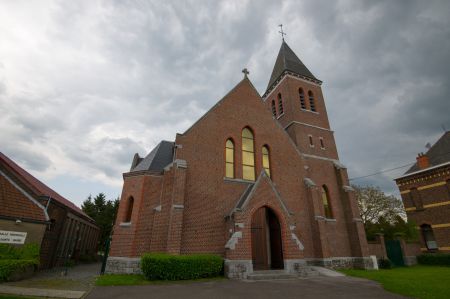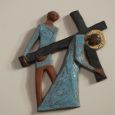Church | 1907 | Neogothic | Catholic Church


Map
Opening hours
01 January - 31 December
Mon 9.00 - 19.00
Tue 9.00 - 19.00
Wed 9.00 - 19.00
Thu 9.00 - 19.00
Fri 9.00 - 19.00
Sat 9.00 - 19.00
Sun 9.00 - 19.00
Religious offices
Saturday 6 pm
Description
This Neo-Gothic church was built in 1907 at the time when the inhabitants worked mainly in the collieries and the steel industry. Thus it is not surprising that the parish is dedicated to Saint Barbe, the patron of miners and metal workers. Her statue is well placed and highly visible on the left of the church.
The beautiful and imposing altar, which according to research by the Abbot Jacques Arcq, curate from 1964 to 1968, has the same dimensions as the altar in the temple of Jerusalem, is in massive olive wood. Looking upwards one sees the vaults as inverted hulls, panelled in varnished chestnut, which provides a sober aspect and a fine resonance. There is also a varnished polychrome ceramic Way of the Cross of which some stations were created by the ceramic workshop of the monastery Jean de Quévy-le-Grand.
KIKIRPA : Photo-library online
Photos
Remarkable elements
The inverted carina vaults in the nave, transepts and choir
Panelled, in varnished chestnut wood, they offer a sober aspect and a remarkable sound to the church. They cover the entire space between the southern gable and the chevet of the choir. Properly oriented lighting highlights this quite original part of this place of worship. We can still see the location of the passage of the cast iron column stove nozzle, which was the building's former means of heating.
Altar
This altar with four arched feet was installed at the initiative of Father Jacques Arcq, the last resident priest of the parish (1964-1968). A customary figure on journeys to the Holy Land, this giant (he measured nearly 2 metres tall!), athletic and popular, had wanted to enhance the prestige of the altar: prepared for celebration in front of the people (wanted by the liturgical reform of the mid-1960s), he conferred on it the precise dimensions, according to his research, of the one... of the temple in Jerusalem!
Stained glass windows
The group of three stained glass windows above the flat chevet of the choir represents the scene of the crucifixion: in the centre, Christ, with Mary Magdalene at the foot of the cross, on the left the Virgin Mary and on the right, Saint John. In the central nave, on the east wall is the Nativity stained glass window and opposite it is the Easter stained glass window. Their authors are not known. Two of these stained glass windows were donated by families from the village
The Way of the Cross and the crib
A Way of the Cross classically adorns the walls of the nave. In varnished and polychrome ceramic, it was donated by the church wardens in La Louvière in April 1991 to replace the previous one, made of plaster and damaged. Several stations, which were not present, were recreated by the ceramics workshop of the Saint-Jean de Quévy-le-Grand monastery; this delicate work was completed and completed with a 15th station representing the open tomb. We also owe to this workshop the remarkable terracotta characters of the crib (1988).
The neo-Gothic confessional
The neo-Gothic confessional dating from the early 20th century is contemporary with the construction of the church. There is only one place left for penitents. Once attached to the south wall, it was recently transferred to the left transept.
The statue and banner of Saint Barbara
In the 19th century and when the parish was founded, there were many coalmining families in this part of the village that made up the parish territory. The statue of the patron saint of miners looks beautiful and is depicted with the tower at its feet attached to her painful and edifying legend. Its current "base" comes from the former pulpit formerly fixed to the right angle of the choir, thus usefully reconverted. The parish banner, in honour and bearing the effigy of the saint, bears the date of 1925.

















